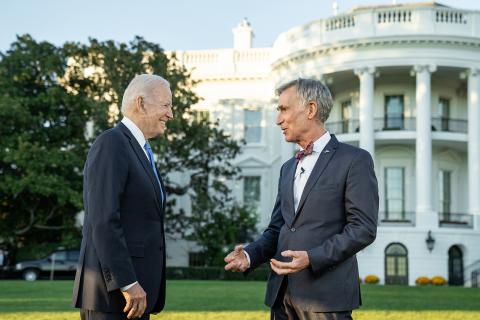Science Guy
Nye Talks Sustainability

Beloved science educator “Bill Nye the Science Guy” took the virtual stage earlier this year to educate federal employees and their children. His presentation, “Protecting the Planet Wherever You Are” was the second installment in the Sustainability Speaker Series for the federal community.
A mechanical engineer by schooling, Nye is best known for his accomplishments as a science communicator and educator. He began his scientific career as a mechanical engineer for Boeing and eventually left to pursue a comedy career, which took off with his famous 90s television series “Bill Nye the Science Guy.”
“I became a mechanical engineer because I like stuff,” he explained. That love of “shiny objects,” as he calls it, translates well to the discipline of climate science because of the many technological problems climate change presents.
What are some of those problems? There are three main ones, according to Nye: clean water, renewable and reliably produced electricity and access to global information (the internet).
“If we had those three things for everybody in the world,” he said, “everybody would be healthy.” A healthier world would also mean that we could have more time and energy to devote to improving the health of the environment.
The main driver of climate change in the world today is the buildup of carbon dioxide gas (CO2) in the atmosphere. This CO2 accumulation is largely produced by burning fossil fuels such as coal, oil and gas to power vehicles and generate electricity.

Photo: Official White House Photo: Adam Schultz
Fossil fuels are the ancient remnants of animal and plant matter that have decomposed and turned into carbon-rich deposits. Humans have figured out how to use those deposits (coal, natural gas and crude oil) for energy. When we burn fossil fuels to generate power, the CO2 gas remains trapped by the Earth’s atmosphere.
CO2 is called a “greenhouse gas” because it traps heat, much like a greenhouse in a garden. Sunlight “passes through these [CO2] molecules and spreads out into a longer wavelength of light, called infrared, when it hits the ground,” Nye explained. “CO2 and other heat-trapping molecules [absorb the infrared energy and] hold it in.”
How can we change our practices and stop excess CO2 from continuing to build up in the atmosphere?
Making sustainable switches in electricity is one change that will have a significant impact on mitigating climate change, Nye said. Transportation produces the highest proportion of greenhouse gas emissions in the U.S. If that isn’t reason enough for change, we have found that gas and diesel motors are also far less efficient than electric ones.
“If we take all the energy in gasoline or diesel fuel and then have [someone] figure out how much energy is theoretically possible to get out of that gallon or liter of gasoline, and then ask how far a car can go on that, it’s barely 30 percent,” Nye explained.
In other words, gas and diesel motors are not very good at using all the energy that is available in their fuel. By comparison, most electric motors are well over 90 percent efficient—and they can also be powered by renewable energy sources such as wind and solar power.
There is still work that needs to be done on these technologies, Nye admitted, suggesting to his audience: “Now, you, the young people out there and everyone watching...I want you to solve these problems.”
His set of tasks involved figuring out how to transition from a centralized electricity grid to one that relies on numerous energy sources, such as offshore wind farms and solar panels on people’s homes. Even young viewers could have an impact, he said, by asking their communities to start centers for recycling.
Nye acknowledged the world is facing a significant set of challenges to halt the progress of climate change, but he emphasized the importance of hope.
“You have to be optimistic; if you aren’t, you won’t get anything done,” he reasoned. “You go to a sports game because you believe your favorite team will win.”
Change is built into our very government, he said, which is why the U.S. has succeeded as a country. And it is that capacity for change that will allow us to be a leader in the global transition to clean energy.
“The government is like science in that it’s changing and improving and working its way toward the so-called more perfect union,” Nye said. And the federal government is taking the lead at home by implementing the Federal Sustainability Plan, which set out five ambitious goals to reduce emissions by federal operations, invest in clean energy and help communities become clean, resilient and healthy. Under this plan, the U.S. government will achieve net-zero emissions by 2050.
At the end of his talk, Nye was asked, “If you could pick any time on Earth to live in, what would you choose and why?”
Perhaps surprisingly, Nye said “this would be the time…as much trouble as there is and as hard as things are, the world is actually better for more people than it has ever been in human history. There is no better time to be alive than right now and changes we are making will change so many people’s lives for the better.”
Visit https://www.sustainability.gov/index.html for more information. To view the archived lecture, visit: https://www.youtube.com/watch?v=xj3grRM1q7o.
